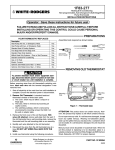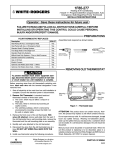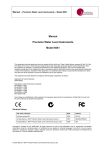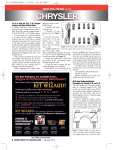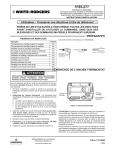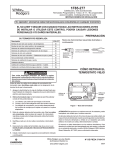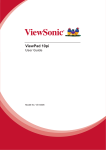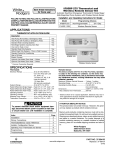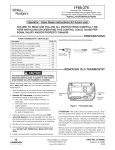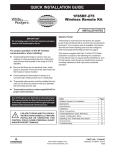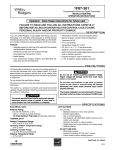Download White Rodgers PART NO. 37-6509A Specifications
Transcript
1F83-277 Heating & Air Conditioning Non-programmable, Auto Changeover, Multi-Stage/Heat Pump Thermostat INSTALLATION INSTRUCTIONS Oper a tor ve these instr uctions ffor or futur e use! Opera tor:: Sa Sav instructions future FAILURE TO READ AND FOLLOW ALL INSTRUCTIONS CAREFULLY BEFORE INSTALLING OR OPERATING THIS CONTROL COULD CAUSE PERSONAL INJURY AND/OR PROPERTY DAMAGE. PREP ARA TIONS PREPARA ARATIONS YOUR THERMOSTAT REPLACES Description 1F83-277 Heat Pump (No Aux. or Emergency Heat) Assemble tools required as shown below. Yes Heat Pump (with Aux. or Emergency Heat) Yes Standard Heat & Cooling Systems Yes Two Stage Heat & Two Stage Cool Yes Standard Heat Only Systems Yes Millivolt Heat Only Systems – Floor or Wall Furnaces Yes Standard Central Air Conditioning Yes Gas or Oil Heat Yes Electric Furnace Yes Hydronic (Hot Water) Zone Heat – 2 Wires Yes Hydronic (Hot Water) Zone Heat – 3 Wires No FLAT BLADE SCREWDRIVER WIRE CUTTER/STRIPPER HAND OR POWER DRILL WITH 3/16 INCH DRILL BIT, IF NEEDED REMO VING OLD THERMOST AT REMOVING THERMOSTA ! CAUTION To prevent electrical shock and/or equipment damage, disconnect electric power to system at main fuse or circuit breaker box until installation is complete. Before removing wires from old thermostat's switching subbase, label each wire with the terminal designation it was removed from. Y2 C 1. Shut off electricity at the main fuse box until installation is complete. Ensure that electrical power is disconnected. 2. Remove Old Thermostat Thermostat: A standard heat/cool thermostat consists of three basic parts: a. The cover, which may be either a snap-on or hinge type. b. The base, which is removed by loosening all captive screws. c. The switching subbase, which is removed by unscrewing the mounting screws that hold it on the wall or adaptor plate. 3. Remove the front cover of the old thermostat. With wires still attached attached, remove wall plate from the wall. If the old thermostat has a wall mounting plate, remove the thermostat and the wall mounting plate as an assembly. 4. Identify each wire attached to the old thermostat. 5. Disconnect the wires from the old thermostat one at a time. DO NOT LET WIRES FALL BACK INTO THE WALL WALL. 6. Install new thermostat using the following procedures. R E/W1 O Mounting Hole B Y1 L W2 G ELEC. ON Mounting Hole GAS AUTO Elec-Gas Switch Figure 1 – Thermostat base ATTENTION! This product does not contain mercury. However, this product may replace a unit which contains mercury. Do not open mercury cells. If a cell becomes damaged, do not touch any spilled mercury. Wearing non-absorbent gloves, clean up the spilled mercury and place into a container which can be sealed. If a cell becomes damaged, the unit should be discarded. Mercury must not be discarded in household trash. When the unit this product is replacing is to be discarded, place in a suitable container and refer to www.white-rodgers.com for the location to send product containing mercury. White-Rodgers is a division of Emerson Electric Co. www.white-rodgers.com PART NO. 37-6509E Replaces 37-6509D 0818 MOUNTING AND WIRING ! CAUTION ! WARNING Take care when securing and routing wires so they do not short to adjacent terminals or rear of thermostat. Personal injury and/or property damage may occur. Do not use on circuits exceeding specified voltage. Higher voltage will damage control and could cause shock or fire hazard. Attach Thermostat Base to Wall Do not short out terminals on gas valve or primary control to test. Short or incorrect wiring will damage thermostat and could cause personal injury and/or property damage. 1. Remove the packing material from the thermostat. Gently pull the cover straight off the base. Forcing or prying on the thermostat will cause damage to the unit. 2. Connect wires beneath terminal screws on base using appropriate wiring schematic (see figs. 2 through 4). Thermostat installation and all components of the system shall conform to Class II circuits per the NEC code. 3. Place base over hole in wall and mark mounting hole locations on wall using base as a template. 4. Move base out of the way. Drill mounting holes. Electric/Gas Switch (Fan Option) 5. Fasten base loosely to wall, as shown in fig. 1, using two mounting screws. Place a level against bottom of base, adjust until level, and then tighten screws. (Leveling is for appearance only and will not affect thermostat operation.) If you are using existing mounting holes, or if holes drilled are too large and do not allow you to tighten base snugly, use plastic screw anchors to secure subbase. This thermostat is configured from the factory to operate a heat/ cool, fossil fuel (gas, oil, etc.), forced air system. It is configured correctly for any system that DOES NOT require the thermostat to energize the fan on a call for heat. If you system is an electric heat or heat-pump system that REQUIRES the thermostat to turn on the fan on a call for heat, locate the ELEC/GAS switch on the back of the thermostat (see fig. 1) and switch it to the ELEC position. This will allow the thermostat to energize the fan immediately on a call for heat. If you are unsure if the heating/ cooling system requires the thermostat to control the fan, contact a qualified heating and air conditioning service person. 6. Push excess wire into wall and plug hole with a fireresistant material (such as fiberglass insulation) to prevent drafts from affecting thermostat operation. Battery Location 2 “AA” alkaline batteries are included in the thermostat at the factory with a battery tag to prevent power drainage. You must remove the battery tag to engage the batteries. When the thermostat is configured for Heat Pump, the thermostat will always power the circulator fan on a call for heat in the HEAT mode. The ELEC/GAS switch must be set to match the type of Auxiliary heat your system uses for proper operation in the EMERgency mode. If “BATT” is displayed, the batteries are low and should be replaced. For best results, replace all batteries with new premium brand alkaline batteries such as Duracell® or Energizer®. To replace batteries, press system button to OFF, install the batteries along the top of the base (see Fig. 1). The batteries must be installed with the positive (+) end to the left. All wiring diagrams are for typical systems only. Refer to equipment manufacturers’ instructions for specific system wiring information. E/W1 O B Y2 Reversing Valve Energized in Cool Mode Reversing Valve Energized in Heat, Off, Emergency Mode 2nd Stage Compressor Y1 Compressor Contactor G Fan Relay W2 Aux Heat Relay C THERMOSTAT * L R SYSTEM SYSTEM MONITOR SWITCH Emergency Heat Relay Hot 24 VAC 120 VAC Neutral Figure 2. Typical wiring diagram for single transformer heat pump systems TRANSFORMER (Class II Current Limited) *The 24 volt neutral connection to terminal C on the thermostat is not required if you replace the batteries once a year with fresh “AA” alkaline batteries. NOTE If safety circuits are in only one of the systems, remove the transformer of the system with NO safety circuits. E/W1 O CUT AND TAPE OFF! HOT 120 VAC NEUTRAL 24 VAC B Y2 Y1 Reversing Reversing 2nd Stage Valve Valve Compressor Energized in Energized in Heat, Off, Compressor Cool Mode Emergency Contactor Mode G W2 Fan Relay Aux Heat Relay C Emergency Heat Relay THERMOSTAT * L SYSTEM MONITOR SWITCH R SYSTEM Limit or Safety Switches Hot 24 VAC 120 VAC Neutral TWO COMMONS MUST BE JUMPERED TOGETHER! TRANSFORMER (Class II Current Limited) Figure 3. Typical wiring diagram for two transformer heat pump systems with NO safety circuits *The 24 volt neutral connection to terminal C on the thermostat is not required if you replace the batteries once a year with fresh “AA” alkaline batteries. WIRING DIA GRAMS DIAGRAMS NOTE Polarity must be observed. If the HOT side of the second transformer is jumpered to the COMMON side of the first transformer a short will be made. Damage to equipment will occur when power is restored. E/W1 O B Y2 Y1 G W2 C THERMOSTAT * L R SYSTEM Reversing Valve Reversing 2nd Stage Energized in Compressor Valve Energized in Heat, Off, Compressor Cool Mode Emergency Mode Contactor Emergency Heat Relay Fan Relay Limit or Safety Switches SYSTEM MONITOR SWITCH 24 VAC 120 VAC Limit or Safety HOT Switches NEUTRAL 24 VAC ACCESSORY RELAY N.O. CONTACT Aux Heat Relay Auxiliary NOTE Heating Transformer The accessory relay scheme (Class II is required when safety Current Limited) circuits exist in both systems. COMMON Limit or Safety Switches TWO COMMONS MUST BE JUMPERED TOGETHER! Limit or Safety Switches 24 VAC COMMON HOT 120 VAC NEUTRAL Heat Pump Transformer (Class II Current Limited) Figure 4. Typical wiring diagram for two transformer heat pump systems with safety circuits in BOTH systems *The 24 volt neutral connection to terminal C on the thermostat is not required if you replace the batteries once a year with fresh “AA” alkaline batteries. Heat Pump Terminal Outputs Refer to equipment manufacturers' instructions for specific system wiring information. You can configure the thermostat for use with the following heat pump system types: HEAT PUMP TYPE 1. Single stage compressor system; gas or electric backup. This thermostat is designed to operate a single-transformer system. If you have a two-transformer system, cut and tape off SYSTEM Heat Pump 1 Heat Pump 2 L C* R Fault 24 Volt 24 Volt Indicator (Common) (Hot) or System Malfunction Switch one transformer. If transformer safety circuits are in only one of the systems, remove the transformer of the system with NO safety circuits. If required, replace remaining transformer with a 75VA Class II transformer. After disconnecting one transformer, the two commons must be jumpered together. Use the terminal output information below to help you wire the thermostat properly for your heat pump system. After wiring, see CONFIGURATION section for proper thermostat configuration. THERMOSTAT TERMINALS (HEAT PUMP) E/W1 Y2 Y1 W2 G O B Heat Mode Emergency No Heat and Blower/Fan Energized Energized Energized 2nd stage, Mode Output Cool mode on call for Heat in Cool in Heat Emergency 1st stage 1st stage and Cool Mode OFF Mode 2nd 2nd (compressor) Set GAS/ELEC switch Emergency stage stage for Emergency mode mode compressor Heat Mode 3rd stage, Emergency Mode 2nd stage *The 24 volt neutral connection to terminal C on the thermostat is not required if you replace the batteries once a year with fresh “AA” alkaline batteries. E/W1 B O Y2 Y1 W2 G C * THERMOSTAT R SYSTEM Reversing Valve Energized in Cool Mode Compressor Heat Contactor Stage 2 Relay Stage 1 Reversing Valve Energized in Heat Mode Off Emergency Hot 24 VAC Compressor Contactor Stage 1 Fan Relay Heat Relay Stage 2 120 VAC Neutral TRANSFORMER (Class II, Current Limited) Figure 5. Typical wiring diagram for single transformer multi-stage systems *The 24 volt neutral connection to terminal C on the thermostat is not required if you replace the batteries once a year with fresh “AA” alkaline batteries. Multi-Stage Terminal Outputs Refer to equipment manufacturers' instructions for specific system wiring information. You can configure the thermostat for use with either multi-stage electric heat systems or multi-stage gas systems. When configured for electric heat, the G terminal (blower/fan) will be energized on a call for heat. This thermostat is designed to operate a single-transformer system. If you have a two-transformer system, cut and tape off SYSTEM L C* R one transformer. If transformer safety circuits are in only one of the systems, remove the transformer of the system with NO safety circuits. If required, replace remaining transformer with a 75VA Class II transformer. After disconnecting one transformer, the two commons must be jumpered together. Use the terminal output information below to help you wire the thermostat properly for your multi-stage system. After wiring, see CONFIGURATION section for proper thermostat configuration. THERMOSTAT TERMINALS (MULTI-STAGE) W2 E/W1 Y2 Y1 G O B Multi-stage Malfunction 24 Volt 24 Volt Heat Mode Heat mode Cool Mode Cool Mode Blower/Fan Energized Energized Energized Light (Common) (Hot) 2nd stage 1st stage 2nd stage 1st stage on call for Cool (and in Cool in Heat, Off, Heat if configured Mode Emergency to Electric Heat) Modes *The 24 volt neutral connection to terminal C on the thermostat is not required if you replace the batteries once a year with fresh “AA” alkaline batteries. CHECK THERMOST AT OPERA TION THERMOSTA OPERATION NOTE To prevent static discharge problems, touch side of thermostat to release static build-up before touching any keys. If at any time during testing your system does not operate properly, contact a qualified service person. Fan Operation If your system does not have a G terminal connection, skip to Heating System. 1. Turn on power to system. 2. Move FAN switch to ON position. The blower should be gin to operate. 3. Move FAN switch to AUTO position. The blower should stop immediately. ! CAUTION Do not allow the compressor to run unless the compressor oil heaters have been operational for 6 hours and the system has not been operational for at least 5 minutes. Heating System 1. Press SYSTEM button to select the Flame icon ( ). If the auxiliary heating system has a standing pilot, be sure to light it. to adjust thermostat setting to 1° above room 2. Press temperature. The heating system should begin to operate. The display should show “STG1”. However, if the setpoint temperature display is flashing, the compressor lockout feature is operating (see Configuration menu, item 5). 3. Adjust temperature setting to 3° above room temperature. If your system configuration is set at MS2, HP2 or HP1, the auxiliary heat system should begin to operate and the display should show “STG1+2”. to adjust the thermostat below room tempera4. Press ture. The heating system should stop operating. 4 Emergency System EMER bypasses the Heat Pump to use the heat source wired to terminal E on the thermostat. EMER is typically used when compressor operation is not desired, or you prefer back-up heat only. 1. Press SYSTEM button to select EMER. “EMER” will flash on the display. to adjust thermostat setting above room 2. Press temperature. The Aux. heating system will begin to operate. The display will show “STG1” flashing “EMER” and Flame icon ( ) to indicate that the Aux. system is operating. 3. Adjust temperature setting to 3° above room temperature. The auxiliary heat system should begin to operate and the display should show “STG1+2”. to adjust the thermostat below room tempera4. Press ture. The Aux. heating system should stop operating. ! CAUTION To prevent compressor and/or property damage, if the outdoor temperature is below 50°F, DO NOT operate the cooling system. Cooling System 1. Press SYSTEM button to select the Snowflake icon ( ). 2. Press to adjust thermostat setting below room temperature. The blower should come on immediately on high speed, followed by cold air circulation. The display should show “STG1”. 3. Adjust temperature setting to 3° below room temperature. The second stage cooling should begin to operate and the display should show “STG1+2”. to adjust the temperature setting above room 4. Press temperature. The cooling system should stop operating. OPERA TION OPERATION Before you begin programming your thermostat, you should be familiar with its features and with the display and the location and operation of the thermostat buttons. Your thermostat consists of two parts: the thermostat cover and the base. To remove the cover, pull it straight out from the base. To replace the cover, line up the cover with the base and press until the cover snaps onto the base. The Thermostat Buttons and Switches 1 Raises temperature setting 2 Lowers temperature setting. 3 FAN switch (ON, AUTO) 4 SYSTEM button (COOL, AUTO, HEAT, EMER, OFF) STG1+2 FAULT EMER The Display 5 Flame icon ( ) is displayed when the system is in HEAT mode. Snowflake icon ( ) is displayed when the system is in COOL mode. Flame icon ( ) and Snowflake icon ( ) are displayed simultaneously when thermostat is in AUTO mode. 6 Displays “BATT” when the 2 "AA" batteries are low and should be replaced. Only “BATT” and “LO” in the minutes field are displayed when batteries are low and with no system power. 7 Displays current temperature or “LO” in the minutes field when batteries are low. 8 Displays set temperature (this is blank when SYSTEM is OFF). 9 Displays “FLTR” when the system has run for the programmed filter time period as a reminder to change or clean your filter. 10 Display ( ) when in keypad lockout mode. 11 “EMER” is displayed flashing when the system is in Figure 6 – Thermostat display, buttons and switches 12 “FAULT” will be displayed when there is a malfunction in the HEAT/COOL system. 13 Display ( ) when limited HEAT/COOL range is activated. The “ ” icon will flash if an attempt is made to adjust the temperature beyond the limited HEAT/COOL temperature range. 14 Stage 1 & 2 indicators: The thermostat shall indicate when the first and second stage is energized except in emergency mode. The icon is “STG 1” for the first stage energized. The icons for the first and second stage energized are “STG1+2” located in the upper right side of the display. EMER mode. CONFIGURA TION MENU CONFIGURATION The configuration menu allows you to set certain thermostat operating characteristics to your system or personal requirements. Set SYSTEM button to OFF, then simultaneously press and to enter configuration menu. The display will show the first item in the configuration menu. The configuration menu table summarizes the configuration options. An explanation of each option follows. Press SYSTEM to change to the next menu item. To exit the menu and return to the program operation, press RUN. If no keys are pressed within fifteen minutes, the thermostat will revert to normal operation. 1) Single Stage, Multi-stage or Heat Pump System Configuration – This control can be configured for Heat Pump or two stage heat/two stage cool multi-stage operation. The display indicates “MS 2” (default for multi-stage mode) in the display. The Multi-stage configuration can be or toggled to “SS1”, “HP2”, or “HP1” by pressing the key. In Multi-stage configuration, SYSTEM button will not have EMERgency mode. 2) Fast or Slow Cycle Selection – The factory default setting is fast cycle, which cycles 1st stage at approximately 1.2°F and 2nd stage 0.75°F. If you prefer slow cycle, press the or key to change to SL. The 1st stage and 2nd stage would be 1.5°F and 1.2°F respectively. 5 CONFIGURA TION MENU CONFIGURATION Press the SYSTEM button until OFF is displayed, then press the and simultaneously INSTALLER/CONFIGURATION MENU Step Press Button(s) Displayed (Factory Default) Press or to select 1 System MS 2 SS1, HP2, HP1 Selects Single stage, Multi-stage, or Heat Pump (Single stage or 2-stage) System Configuration 2 System FA SL Selects Fast or Slow Cycle Selection 3 System CL (OFF) CL (ON) Selects Compressor Lockout CL OFF or ON 4 System CDL (ON) CDL (OFF) Selects Backlight Display 5 System FA (ON) FA (OFF) Selects Fast Second Stage ON or OFF 6 System 0 FLTR 50-1950 (increments of 50) Selects filter replacement run time 7 System 0°F (Room Temperature) 4 LO to 4 HI Selects Temperature Display Adjustment 4 LO to 4 HI 8 System °F °C Selects temperature display F° or °C selection 9 System AU On OFF Selects AUTO Mode ON or OFF (Not available on earlier models) 10 System LR (90) LR 62 to LR89 Selects Limited HEAT range 11 System LR (45) LR 46 to LR 82 Selects Limited COOL range 12 System CA (OFF) CA (ON) Feature Not Available 13 System (ON) Selects Keypad Lockout 001 to 999 Selects Keypad lockout combination number Press System to set code Comments (OFF) 14 System 15 System 0 3) Select Compressor Lockout CL OFF or ON – Selecting CL ON will cause the thermostat to wait 5 minutes before turning on the compressor if the heating and cooling system loses power. It will also wait 5 minutes minimum between cooling and heating cycles. This is intended to help protect the compressor from short cycling. Some newer compressors already have a time delay built in and do not require this feature. Your compressor manufacturer can tell you if the lockout feature is already present in their system. When the thermostat compressor time delay occurs it will flash the setpoint for about five minutes. 4) Select Backlight Display – The display backlight improves display contrast in low lighting conditions. When the C terminal is powered, selecting backlight CdL ON will turn 6 Returns to the OFF position the light on continuously. Select backlight OFF will keep the light on momentarily after any key is pressed. When the C terminal is not powered, this selection has no effect. 5) Select (Fast) Second Stage ON or OFF – In the run mode, if the setpoint temperature is manually raised by 3°F (2°C) or more above the actual temperature with the , and the fast second stage feature is enabled, FA ON, the second stage will energize immediately. With FA OFF, second stage will not energize until the setpoint temperature is 1°F or more above actual temperature for more than ten minutes. CONFIGURA TION MENU CONFIGURATION 6) Select filter replacement run time – The thermostat will display FLTR after a set time of operation. This is a reminder to change or clean your air filter. This time can be set from 0 to 1950 hours in 50 hour increments. A selection of 000 will cancel this feature. When “FLTR” is displayed, you can clear it by pressing SYSTEM. This resets the timer and starts counting the hours until the next filter change. Contact your system manufacturer for a specific replacement/main tenance interval. 7) Select Temperature Display Adjustment 4 LO to 4 HI – Allows you to adjust the room temperature display up to 4° higher or lower. Your thermostat was accurately calibrated at the factory but you have the option to change the display temperature to match your previous thermostat. The current or adjusted room temperature will be displayed on the left side of the display. 8) Select F° or C° Readout – Changes the display readout to Centigrade or Fahrenheit as required. 9) Selected Auto mode – This control will feature AUTO changeover mode when AU on is selected (default). Press or keys (not available on earlier models) to defeat the the auto changeover mode (OFF). 10)Limited Heat Range – This feature provides a maximum setpoint temperature for heat. The default setting is 90°F. It can be changed between 62°F and 89°F by pressing the or key. 11)Limited Cool Range – This feature provides a minimum setpoint temperature for cool. The default setting is 45°F. It can be changed between 46°F and 82°F by pressing the or key. 13 & 14) Keypad Lockout – This menu selection will display lock icon ( ) and “OFF” (default, keypad not locked out). The and are used to toggle the selection between OFF and ON (keypad locked out). When the keypad lockout selection is enabled (ON), and the SYSTEM button is pressed again, the display will indicate the number “0” and are (default, still disabled) in the time digits. The used to set the combination number from 0 to 999. If a combination of 0 is selected and the SYSTEM button is pressed, the menu will be exited and keypad will not be locked. If 1 to 999 is selected and the SYSTEM button is pressed, the combination is stored into memory and the menu is exited. The ( ) will display designating keypad locked with a valid combination. The SYSTEM button will operate for 10 seconds after the menu mode is exited to allow the user to change the mode from OFF to the desired SYSTEM mode. While the keypad is locked out, a simultaneous press of and will enter the configuration menu from any mode instead of only OFF mode. When the menu is entered with the keypad lockout feature enabled, the first menu item displayed is the combination code 0. The or keys are used to set the combination unlock number from 0 to 999. If the unlock number matches exactly with the combination lock number stored in memory when the SYSTEM button is pressed, the keypad is unlocked and the ( ) is removed. If the unlock number does not match when the SYSTEM button is pressed, the menu is exited and the keypad remains disabled. To reset the combination code and unlock the keypad if the code is forgotten, see troubleshooting section. 12)This Feature Not Available. SPECIFICA TIONS SPECIFICATIONS ELECTRICAL DATA THERMAL DATA Electrical Rating Rating: 20 to 30 VAC 50/60 Hz or DC 0.05 to 1.5 Amps (Load per terminal) 2.5 Amps Maximum Total Load (All terminals combined) Setpoint Temperature Range Range: 45°F to 90°F (7°C to 32°C) Operating Ambient Temperature Range Range: 32°F to 105°F Operating Humidity Range Range: 0 to 90% RH (non-condensing) Shipping Temperature Range Range: -40°F to 150°F 7 OPERA TION OPERATION The system "mode" is selected by pressing the SYSTEM button. Icons on the bottom right corner of the display will indicate the mode: COOL ( ), AUTO ( ), HEAT ( ), EMER EMER, or OFF OFF. In any mode except OFF OFF, the setpoint temperature will be shown on the right side of the display. In OFF OFF, this area will be blank. The current temperature will be displayed on the left side of the display. To operate properly in the AUTO mode, the heat setpoint temperature cannot be the same as or higher than the cool setpoint temperature. The heat setpoint must be at least 1° lower than the cool setpoint. Automatic System Changeover the room temperature is 70° with the equipment using only the first stage of heat. Since the equipment is keeping the temperature within 1° of setpoint, the thermostat will delay second stage for a longer time if you manually raise the temperature or if the room temperature quickly changes. Once the second stage comes on, it will come on sooner the next time there is a difference between the setpoint and the room temperature. The net effect of the staging program is that when the first stage is capable of making temperature the second stage will delay longer. When the thermostat calculates that first stage cannot make temperature in a reasonable time, the second stage will come on sooner. This built in function automatically optimizes the use of additional stages of heat or cool. When the thermostat is in the AUTO mode, both the Flame and Snowflake icons are displayed. The thermostat will call for heat or cool depending on the room temperature. The setpoint temperature displayed will be that of the last mode called. If the last system cycle was heat, the HEAT setpoint will be displayed. If the room temperature raises above the HEAT setpoint and the COOL setpoint and a call for cool is required, the temperature displayed will change to be the COOL setpoint. Second Stage Time Delay Your thermostat is designed to determine the optimum time to activate the second stage. Simply raising the temperature in heating or lowering it in cooling will not always force the thermostat to bring the second stage on quickly. There is a time delay from 0-30 minutes depending on the performance of the first stage of the system. EXAMPLE: For the last 2 hours the thermostat is set on 70° and LOW BATTERY INDICATOR If the 2 “AA” alkaline batteries are low and should be replaced, LO BATT the display will be blank except for “LO BATT”. We recommend replacing batteries every 2 years. If the home is going to be unoccupied for an extended period (over 3 months), the batteries should be replaced before leaving. When the batteries are low, pressing any button will cause the display to operated for ten seconds. After ten seconds, the display will LO BATT be blank except for “LO BATT”. You cannot program with low batteries, but you can override setpoint temperature. After LO BATT “LO BATT” has been displayed for 4 weeks, the thermostat will raise the temperature 10 degrees above your setpoint in COOL mode and will drop the temperature 10 degrees below LO BATT your setpoint in HEAT mode. If the “LO BATT” condition continues, and when it reaches certain value, the thermostat LO BATT will turn off all the loads and “LO BATT” will flash. TR OUBLESHOO TING TROUBLESHOO OUBLESHOOTING Reset Operation If a voltage spike or static discharge blanks out the display or causes erratic thermostat operation, you can reset the thermostat by removing the wires from terminals R and C and removing batteries for 2 minutes. After resetting the thermostat, replace the wires and batteries. If the thermostat has been reset and still does not function correctly, contact your heating/ cooling service person or place of purchase. Symptom Possible Cause Corrective Action No Heat/No Cool/No Fan (common problems) 1. Blown fuse or tripped circuit breaker. 2. Furnace power switch to OFF. 3. Furnace blower compartment door or panel loose or not properly installed. Replace fuse or reset breaker. Turn switch to ON. Replace door panel in proper position to engage safety interlock or door switch. No Heat 1. Pilot light not lit. 2. SYSTEM button not set to HEAT HEAT. Re-light pilot. Press SYSTEM button to HEAT and raise setpoint above room temperature. Verify thermostat and system wires are securely attached. Many furnaces have safety devices that shut down when a lock-out condition occurs. If the heat works intermittently contact the furnace manufacturer or local service person for assistance. 3. Loose connection to thermostat or system. 4. Furnace Lock-Out Condition. Heat may also be intermittent. TR OUBLESHOO TING TROUBLESHOO OUBLESHOOTING Symptom Possible Cause Corrective Action No Heat (continued) 5. Heating system requires service or thermostat requires replacement. Diagnostic: Press SYSTEM button to HEAT and raise the setpoint above room temperature. Within a few seconds the thermostat should make a soft click sound. This sound usually indicates the thermostat is operating properly. If the thermostat does not click, try the reset operation listed above. If the thermostat does not click after being reset contact your heating and cooling service person or place of purchase for a replacement. If the thermostat clicks, contact the furnace manufacturer or a service person to verify the heating is operating correctly. No Cool 1. SYSTEM button not pressed to COOL. Press SYSTEM button to COOL and lower setpoint below room temperature. Verify thermostat and system wires are securely attached. Same procedure as diagnostic for No Heat condition except set the thermostat to COOL and lower the setpoint below the room temperature. There may be up to a five minute delay before the thermostat clicks in Cooling. 2. Loose connection to thermostat or system. 3. Cooling system requires service or thermostat requires replacement. Heat, Cool or Fan Runs Constantly 1. Possible short in wiring. 2. Possible short in thermostat. 3. Possible short in heat/cool/fan system. 4. FAN Switch set to Fan On. Check each wire connection to verify they are not shorted or touching together. No bare wire should stick out from under terminal screws. Try resetting the thermostat as described above. If the condition persists the manufacturer of your system or service person can instruct you on how to test the Heat/Cool system for correct operation. If the system operates correctly, replace the thermostat. Furnace (Air Conditioner) Cycles Too Fast or Too Slow (narrow or wide temperature swing) 1. The location of the thermostat and/or the size of the Heating System may be influencing the cycle rate. Digital thermostats normally provide precise temperature control and may cycle faster than some older mechanical models. A faster cycle rate means the unit turns on and off more frequently but runs for a shorter time so there is no increase in energy use. If you would like to increase the cycle time, choose SL for slow cycle in the menu, step 4. If an acceptable cycle rate is not achieved as received or by choosing slow cycle, contact a local service person for additional suggestions. Thermostat Setting & Thermostat Thermometer Disagree 1. Thermostat thermometer setting requires adjustment. The thermometer can be adjusted +/- 4 degrees. See Temperature Display Adjustment in the Configuration Menu section. Blank Display and/or Keypad Not Responding 1. Voltage spike or static discharge. Use the Reset Operation at top of previous page. Heat Setpoint will not Respond to the Temperature Up Key 1. The desired setpoint conflicts with the setpoint of the COOL mode. Change system mode to COOL. Raise the Cool setpoint. Return to HEAT mode and set desired temperature. Cool Setpoint will not Respond to the Temperature Down Key 1. The desired setpoint conflicts with the setpoint of the HEAT mode. Change system mode to HEAT. Lower the Heat setpoint. Return to COOL mode and set desired temperature. TR OUBLESHOO TING TROUBLESHOO OUBLESHOOTING Symptom Possible Cause Corrective Action Forgot Keypad Lockout Code CAUTION: This resets the thermostat to factory default settings of the configuration menu. After performing this reset, the thermostat will require configuration again. Be sure that you know the required configuration settings before resetting. With the thermostat in any mode, press and at the same time to enter the configuration menu at the point where the lockout code is to be entered. Press and and SYSTEM button at the same time to reset the lockout code, unlock the keypad and reset all configuration menu settings. Why won't my 2nd or 3rd stage come on? First Stage is keeping up with demand Your thermostat is designed to determine the optimum time to activate the second stage. Simply raising the temperature in heating or lowering it in cooling will not always force the thermostat to bring the second stage on quickly. There is a time delay from 0-30 minutes depending on the performance of the first stage of the system. FAQ Symptom Corrective Action My thermostat is reading in Celsius. How do I change it to Fahrenheit? Your thermostat display can be set to display temperature in Fahrenheit or Celsius. This option can be set in the INSTALLER/CONFIGURATION MENU of your thermostat. See page 6 step 12. My display light does not work. Can it be fixed or replaced? Because it is soldered to the circuit board it is not possible to repair or replace. My setpoint temperature is flashing. What does that mean? When the thermostat compressor time delay occurs it will flash the setpoint for about five minutes. This is intended to help protect the compressor from short cycling. How can I get a copy of the Operating Manual for my thermostat? Visit our website at www.white-rodgers.com for operating manuals. 10 NO TES NOTES 11 HOMEOWNER HELP LINE: 1-800-284-2925 The Emerson logo is a trademark and service mark of Emerson Electric Co. St. Louis, Missouri Markham, Ontario www.white-rodgers.com












